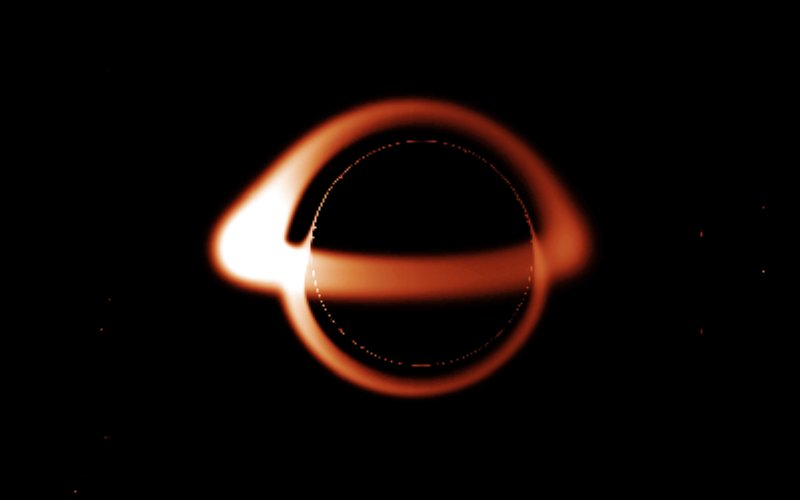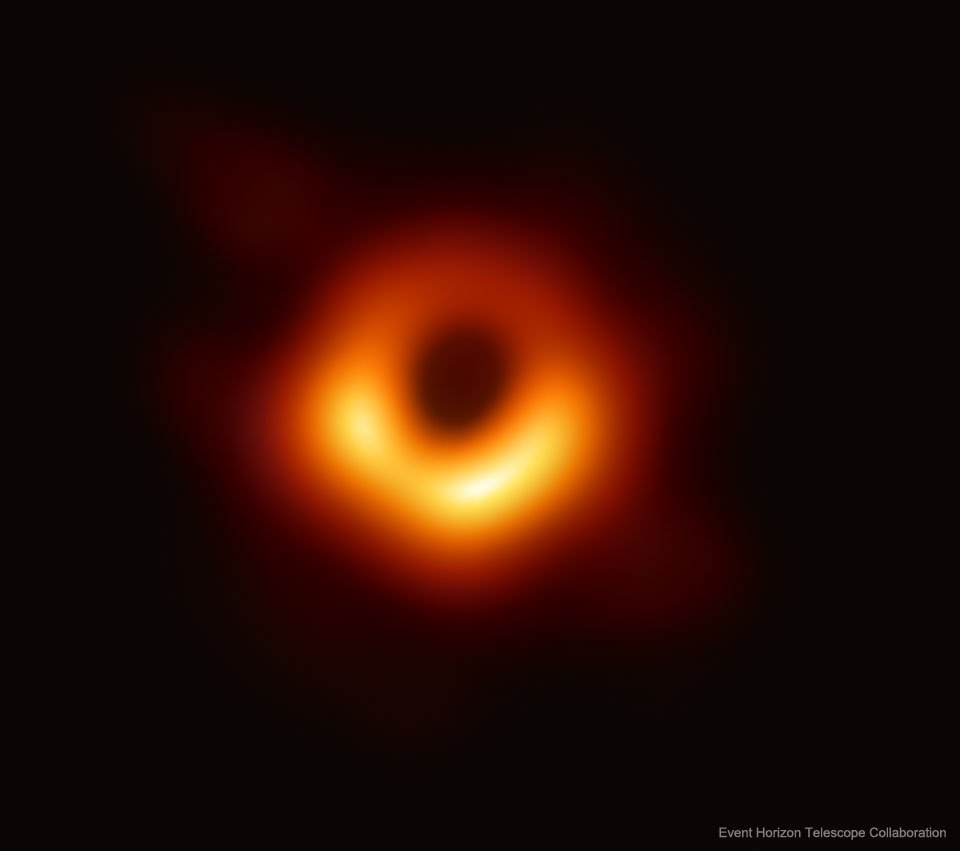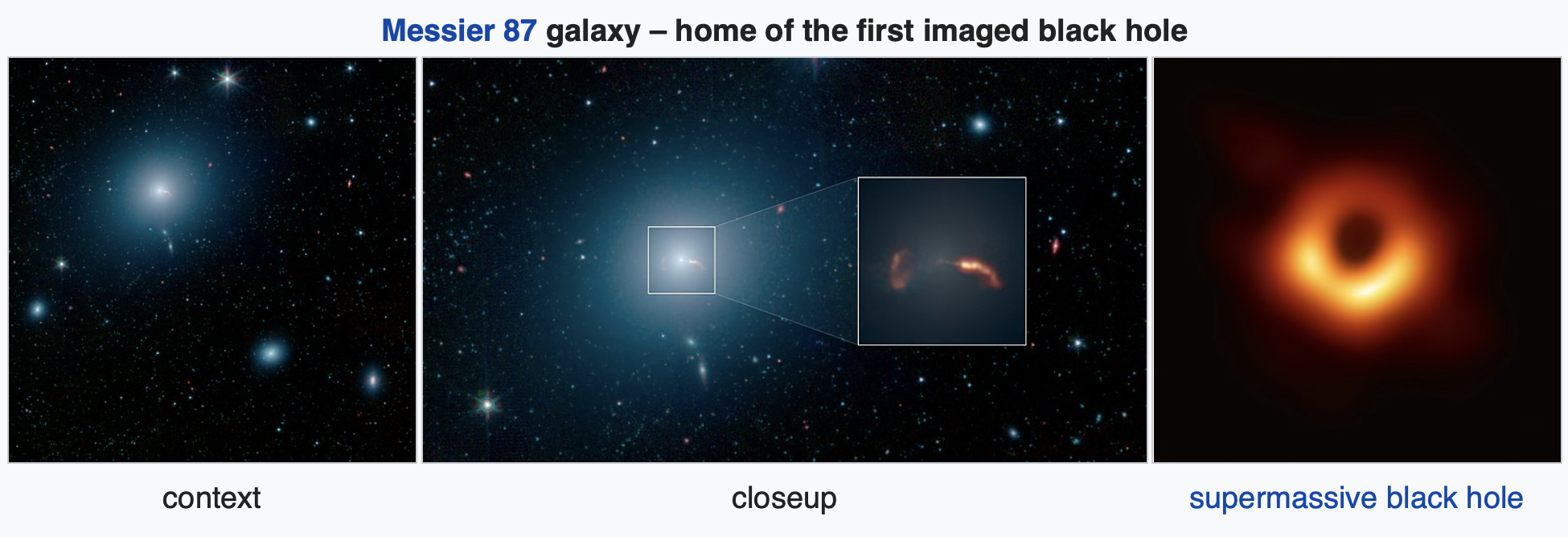Confirmation of Black Holes from Gravitational Waves
../Lecture.20180417/index.html
On September 14th, 2015, a ripple in the fabric of
spacetime, created by the violent collision of two distant
black holes over a billion years ago, washed across the
Earth. As it did, two laser-based Michelson-like
interferometers, 50 years in the making-one in Louisiana and
the other in Washington State-momentarily twitched,
confirming a century-old prediction by Albert Einstein and
marking the opening of a new era in astronomy.
Wikipedia - Black Holes - Observational Evidence
https://en.wikipedia.org/wiki/Black_hole#Observational_evidence

 What does a black hole look like? To find out, radio
telescopes from around the Earth coordinated observations of
black holes with the largest known event horizons on the
sky. Alone, black holes are just black, but these monster
attractors are known to be surrounded by glowing gas. The
first image was released yesterday and resolved the area
around the black hole at the center of galaxy M87 on a scale
below that expected for its event horizon. Pictured, the
dark central region is not the event horizon, but rather the
black hole's shadow -- the central region of emitting gas
darkened by the central black hole's gravity.
Visualization: A Black Hole Accretion Disk (not intuitive for some)
https://apod.nasa.gov/apod/ap200825.html
https://www.youtube.com/watch?time_continue=3&v=l36UkYtq6m0
Explanation: What would it look like to circle a black hole?
If the black hole was surrounded by a swirling disk of
glowing and accreting gas, then the great gravity of the
black hole would deflect light emitted by the disk to make
it look very unusual. The featured animated video gives a
visualization. The video starts with you, the observer,
looking toward the black hole from just above the plane of
the accretion disk. Surrounding the central black hole is a
thin circular image of the orbiting disk that marks the
position of the photon sphere -- inside of which lies the
black hole's event horizon. Toward the left, parts of the
large main image of the disk appear brighter as they move
toward you. As the video continues, you loop over the black
hole, soon looking down from the top, then passing through
the disk plane on the far side, then returning to your
original vantage point. The accretion disk does some
interesting image inversions -- but never appears flat.
Visualizations such as this are particularly relevant today
as black holes are being imaged in unprecedented detail by
the Event Horizon Telescope.
Messier 87
https://en.wikipedia.org/wiki/Messier_87
What does a black hole look like? To find out, radio
telescopes from around the Earth coordinated observations of
black holes with the largest known event horizons on the
sky. Alone, black holes are just black, but these monster
attractors are known to be surrounded by glowing gas. The
first image was released yesterday and resolved the area
around the black hole at the center of galaxy M87 on a scale
below that expected for its event horizon. Pictured, the
dark central region is not the event horizon, but rather the
black hole's shadow -- the central region of emitting gas
darkened by the central black hole's gravity.
Visualization: A Black Hole Accretion Disk (not intuitive for some)
https://apod.nasa.gov/apod/ap200825.html
https://www.youtube.com/watch?time_continue=3&v=l36UkYtq6m0
Explanation: What would it look like to circle a black hole?
If the black hole was surrounded by a swirling disk of
glowing and accreting gas, then the great gravity of the
black hole would deflect light emitted by the disk to make
it look very unusual. The featured animated video gives a
visualization. The video starts with you, the observer,
looking toward the black hole from just above the plane of
the accretion disk. Surrounding the central black hole is a
thin circular image of the orbiting disk that marks the
position of the photon sphere -- inside of which lies the
black hole's event horizon. Toward the left, parts of the
large main image of the disk appear brighter as they move
toward you. As the video continues, you loop over the black
hole, soon looking down from the top, then passing through
the disk plane on the far side, then returning to your
original vantage point. The accretion disk does some
interesting image inversions -- but never appears flat.
Visualizations such as this are particularly relevant today
as black holes are being imaged in unprecedented detail by
the Event Horizon Telescope.
Messier 87
https://en.wikipedia.org/wiki/Messier_87
 Messier 87 (also known as Virgo A or NGC 4486, generally
abbreviated to M87) is a supergiant elliptical galaxy in the
constellation Virgo. One of the most massive galaxies in the
observable universe, it has a large population of globular
clusters-about 12,000 compared with the 150-200 orbiting the
Milky Way-and a jet of energetic plasma that originates at
the core.
Einstein's description of gravity just got much harder to beat
https://phys.org/news/2020-10-einstein-description-gravity-harder.html
Einstein's theory of general relativity—the idea that
gravity is matter warping spacetime—has withstood over 100
years of scrutiny and testing, including the newest test
from the Event Horizon Telescope collaboration, published
today in the latest issue of Physical Review Letters.
According to the findings, Einstein's theory just got 500
times harder to beat.
Despite its successes, Einstein's robust theory remains
mathematically irreconcilable with quantum mechanics, the
scientific understanding of the subatomic world. Testing
general relativity is important because the ultimate theory
of the universe must encompass both gravity and quantum
mechanics.
Wikipedia - Sagittarius A*
https://en.wikipedia.org/wiki/Sagittarius_A*#Orbiting_stars
Sagittarius A*, (abbreviated Sgr A*) is a bright and very
compact astronomical radio source at the center of the Milky
Way, near the border of the constellations Sagittarius and
Scorpius about 5.6 deg south of the ecliptic. It is likely
the location of a supermassive black hole, similar to those
generally accepted to be at the centers of most if not all
spiral and elliptical galaxies.
Observations of a number of stars orbiting around
Sagittarius A*, have led some scientists to conclude that
Sagittarius A* is beyond any reasonable doubt the site of
that black hole.
Three Scientists Awarded Nobel Prize In Physics For Discoveries
Related To Black Holes
https://www.npr.org/2020/10/06/920647525/3-scientists-awarded-nobel-prize-in-physics-for-discoveries-related-to-black-hol
Sam says: This is the first time the awarding of the Nobel
Prize in Physics feels very personal - Roger Penrose,
Reinhard Genzel and Andrea Gehz. I know their faces, their
voices, their work, and in the case of Genzel and Gehz, some
of their emotions. For many years I shared their work with
my astronomy students.
Genzel and Ghez won the other half for painstaking
observations of the supermassive black hole at the center of
our own galaxy. Known as Sagittarius A*, it is more than 4
million times the mass of our sun. Sagittarius A* is
shrouded behind a cloud of gas at the very core of the Milky
Way, but undeterred, Genzel and Ghez used infrared
telescopes to look through the gas. They painstakingly
developed technologies to remove distortions caused by the
gas and by Earth's own atmosphere to track objects orbiting
very close to the black hole.
Roger Penrose, Reinhard Genzel and Andrea Ghez were awarded the Nobel Prize in Physics for their studies of black holes.
https://www.quantamagazine.org/physics-nobel-awarded-for-black-hole-breakthroughs-20201006/
Messier 87 (also known as Virgo A or NGC 4486, generally
abbreviated to M87) is a supergiant elliptical galaxy in the
constellation Virgo. One of the most massive galaxies in the
observable universe, it has a large population of globular
clusters-about 12,000 compared with the 150-200 orbiting the
Milky Way-and a jet of energetic plasma that originates at
the core.
Einstein's description of gravity just got much harder to beat
https://phys.org/news/2020-10-einstein-description-gravity-harder.html
Einstein's theory of general relativity—the idea that
gravity is matter warping spacetime—has withstood over 100
years of scrutiny and testing, including the newest test
from the Event Horizon Telescope collaboration, published
today in the latest issue of Physical Review Letters.
According to the findings, Einstein's theory just got 500
times harder to beat.
Despite its successes, Einstein's robust theory remains
mathematically irreconcilable with quantum mechanics, the
scientific understanding of the subatomic world. Testing
general relativity is important because the ultimate theory
of the universe must encompass both gravity and quantum
mechanics.
Wikipedia - Sagittarius A*
https://en.wikipedia.org/wiki/Sagittarius_A*#Orbiting_stars
Sagittarius A*, (abbreviated Sgr A*) is a bright and very
compact astronomical radio source at the center of the Milky
Way, near the border of the constellations Sagittarius and
Scorpius about 5.6 deg south of the ecliptic. It is likely
the location of a supermassive black hole, similar to those
generally accepted to be at the centers of most if not all
spiral and elliptical galaxies.
Observations of a number of stars orbiting around
Sagittarius A*, have led some scientists to conclude that
Sagittarius A* is beyond any reasonable doubt the site of
that black hole.
Three Scientists Awarded Nobel Prize In Physics For Discoveries
Related To Black Holes
https://www.npr.org/2020/10/06/920647525/3-scientists-awarded-nobel-prize-in-physics-for-discoveries-related-to-black-hol
Sam says: This is the first time the awarding of the Nobel
Prize in Physics feels very personal - Roger Penrose,
Reinhard Genzel and Andrea Gehz. I know their faces, their
voices, their work, and in the case of Genzel and Gehz, some
of their emotions. For many years I shared their work with
my astronomy students.
Genzel and Ghez won the other half for painstaking
observations of the supermassive black hole at the center of
our own galaxy. Known as Sagittarius A*, it is more than 4
million times the mass of our sun. Sagittarius A* is
shrouded behind a cloud of gas at the very core of the Milky
Way, but undeterred, Genzel and Ghez used infrared
telescopes to look through the gas. They painstakingly
developed technologies to remove distortions caused by the
gas and by Earth's own atmosphere to track objects orbiting
very close to the black hole.
Roger Penrose, Reinhard Genzel and Andrea Ghez were awarded the Nobel Prize in Physics for their studies of black holes.
https://www.quantamagazine.org/physics-nobel-awarded-for-black-hole-breakthroughs-20201006/

 Astronomers Are Using Black Hole Echoes to Help Map The Universe
https://www.sciencealert.com/echoes-from-black-holes-could-be-the-next-big-thing-in-mapping-the-cosmos
sam.wormley@icloud.com
Astronomers Are Using Black Hole Echoes to Help Map The Universe
https://www.sciencealert.com/echoes-from-black-holes-could-be-the-next-big-thing-in-mapping-the-cosmos
sam.wormley@icloud.com

What does a black hole look like? To find out, radio telescopes from around the Earth coordinated observations of black holes with the largest known event horizons on the sky. Alone, black holes are just black, but these monster attractors are known to be surrounded by glowing gas. The first image was released yesterday and resolved the area around the black hole at the center of galaxy M87 on a scale below that expected for its event horizon. Pictured, the dark central region is not the event horizon, but rather the black hole's shadow -- the central region of emitting gas darkened by the central black hole's gravity. Visualization: A Black Hole Accretion Disk (not intuitive for some) https://apod.nasa.gov/apod/ap200825.html https://www.youtube.com/watch?time_continue=3&v=l36UkYtq6m0 Explanation: What would it look like to circle a black hole? If the black hole was surrounded by a swirling disk of glowing and accreting gas, then the great gravity of the black hole would deflect light emitted by the disk to make it look very unusual. The featured animated video gives a visualization. The video starts with you, the observer, looking toward the black hole from just above the plane of the accretion disk. Surrounding the central black hole is a thin circular image of the orbiting disk that marks the position of the photon sphere -- inside of which lies the black hole's event horizon. Toward the left, parts of the large main image of the disk appear brighter as they move toward you. As the video continues, you loop over the black hole, soon looking down from the top, then passing through the disk plane on the far side, then returning to your original vantage point. The accretion disk does some interesting image inversions -- but never appears flat. Visualizations such as this are particularly relevant today as black holes are being imaged in unprecedented detail by the Event Horizon Telescope. Messier 87 https://en.wikipedia.org/wiki/Messier_87
Messier 87 (also known as Virgo A or NGC 4486, generally abbreviated to M87) is a supergiant elliptical galaxy in the constellation Virgo. One of the most massive galaxies in the observable universe, it has a large population of globular clusters-about 12,000 compared with the 150-200 orbiting the Milky Way-and a jet of energetic plasma that originates at the core. Einstein's description of gravity just got much harder to beat https://phys.org/news/2020-10-einstein-description-gravity-harder.html Einstein's theory of general relativity—the idea that gravity is matter warping spacetime—has withstood over 100 years of scrutiny and testing, including the newest test from the Event Horizon Telescope collaboration, published today in the latest issue of Physical Review Letters. According to the findings, Einstein's theory just got 500 times harder to beat. Despite its successes, Einstein's robust theory remains mathematically irreconcilable with quantum mechanics, the scientific understanding of the subatomic world. Testing general relativity is important because the ultimate theory of the universe must encompass both gravity and quantum mechanics. Wikipedia - Sagittarius A* https://en.wikipedia.org/wiki/Sagittarius_A*#Orbiting_stars Sagittarius A*, (abbreviated Sgr A*) is a bright and very compact astronomical radio source at the center of the Milky Way, near the border of the constellations Sagittarius and Scorpius about 5.6 deg south of the ecliptic. It is likely the location of a supermassive black hole, similar to those generally accepted to be at the centers of most if not all spiral and elliptical galaxies. Observations of a number of stars orbiting around Sagittarius A*, have led some scientists to conclude that Sagittarius A* is beyond any reasonable doubt the site of that black hole. Three Scientists Awarded Nobel Prize In Physics For Discoveries Related To Black Holes https://www.npr.org/2020/10/06/920647525/3-scientists-awarded-nobel-prize-in-physics-for-discoveries-related-to-black-hol Sam says: This is the first time the awarding of the Nobel Prize in Physics feels very personal - Roger Penrose, Reinhard Genzel and Andrea Gehz. I know their faces, their voices, their work, and in the case of Genzel and Gehz, some of their emotions. For many years I shared their work with my astronomy students. Genzel and Ghez won the other half for painstaking observations of the supermassive black hole at the center of our own galaxy. Known as Sagittarius A*, it is more than 4 million times the mass of our sun. Sagittarius A* is shrouded behind a cloud of gas at the very core of the Milky Way, but undeterred, Genzel and Ghez used infrared telescopes to look through the gas. They painstakingly developed technologies to remove distortions caused by the gas and by Earth's own atmosphere to track objects orbiting very close to the black hole. Roger Penrose, Reinhard Genzel and Andrea Ghez were awarded the Nobel Prize in Physics for their studies of black holes. https://www.quantamagazine.org/physics-nobel-awarded-for-black-hole-breakthroughs-20201006/

Astronomers Are Using Black Hole Echoes to Help Map The Universe https://www.sciencealert.com/echoes-from-black-holes-could-be-the-next-big-thing-in-mapping-the-cosmos sam.wormley@icloud.com